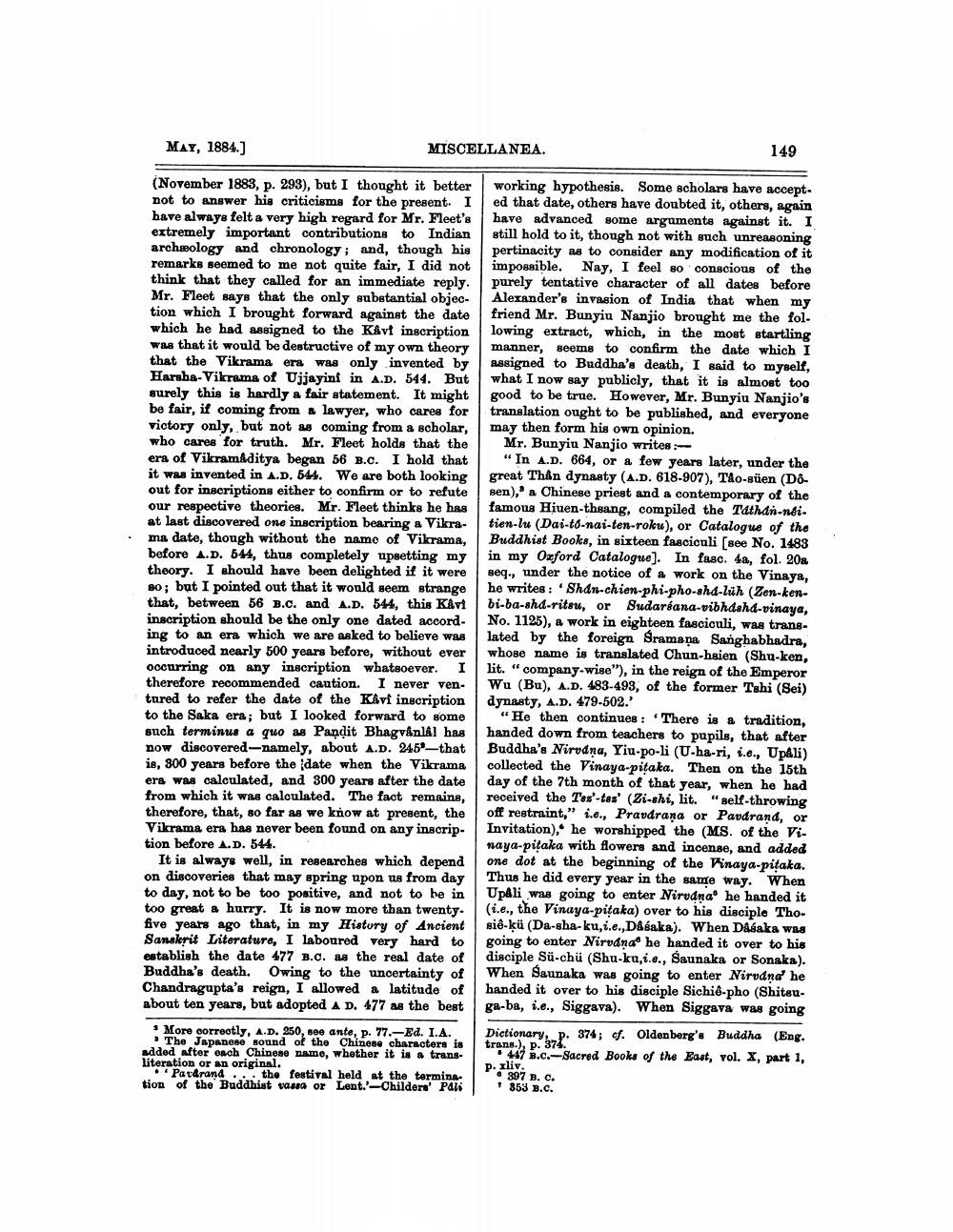________________
MAY, 1884.]
(November 1883, p. 293), but I thought it better not to answer his criticisms for the present. I have always felt a very high regard for Mr. Fleet's extremely important contributions to Indian archæology and chronology; and, though his remarks seemed to me not quite fair, I did not think that they called for an immediate reply. Mr. Fleet says that the only substantial objection which I brought forward against the date which he had assigned to the K&vt inscription was that it would be destructive of my own theory that the Vikrama era was only invented by Harsha-Vikrama of Ujjayini in A.D. 544. But surely this is hardly a fair statement. It might be fair, if coming from a lawyer, who cares for victory only, but not as coming from a scholar, who cares for truth. Mr. Fleet holds that the era of Vikramaditya began 56 B.C. I hold that it was invented in A.D. 544. We are both looking out for inscriptions either to confirm or to refute our respective theories. Mr. Fleet thinks he has at last discovered one inscription bearing a Vikrama date, though without the name of Vikrama, before A.D. 544, thus completely upsetting my theory. I should have been delighted if it were so; but I pointed out that it would seem strange that, between 56 B.C. and A.D. 544, this Kavi inscription should be the only one dated according to an era which we are asked to believe was introduced nearly 500 years before, without ever occurring on any inscription whatsoever. I therefore recommended caution. I never ventured to refer the date of the Kavi inscription to the Saka era; but I looked forward to some such terminus a quo as Pandit Bhagvânlâl has now discovered-namely, about A.D. 245'-that is, 300 years before the ¡date when the Vikrama era was calculated, and 300 years after the date from which it was calculated. The fact remains, therefore, that, so far as we know at present, the Vikrama era has never been found on any inscription before A.D. 544.
MISCELLANEA.
It is always well, in researches which depend on discoveries that may spring upon us from day to day, not to be too positive, and not to be in too great a hurry. It is now more than twentyfive years ago that, in my History of Ancient Sanskrit Literature, I laboured very hard to establish the date 477 B.C. as the real date of Buddha's death. Owing to the uncertainty of Chandragupta's reign, I allowed a latitude of about ten years, but adopted A D. 477 as the best
More correctly, A.D. 250, see ante, p. 77.-Ed. I.A. The Japanese sound of the Chinese characters is added after each Chinese name, whether it is a transliteration or an original.
Pavarand... the festival held at the termination of the Buddhist vassa or Lent.'-Childers' Pali
149
working hypothesis. Some scholars have accepted that date, others have doubted it, others, again have advanced some arguments against it. I still hold to it, though not with such unreasoning pertinacity as to consider any modification of it impossible. Nay, I feel so conscious of the purely tentative character of all dates before Alexander's invasion of India that when my friend Mr. Bunyiu Nanjio brought me the following extract, which, in the most startling manner, seems to confirm the date which I assigned to Buddha's death, I said to myself, what I now say publicly, that it is almost too good to be true. However, Mr. Bunyiu Nanjio's translation ought to be published, and everyone may then form his own opinion.
Mr. Bunyiu Nanjio writes:
"In A.D. 664, or a few years later, under the great Thân dynasty (A.D. 618-907), Tão-süen (Dôsen), a Chinese priest and a contemporary of the famous Hiuen-thsang, compiled the Tathan-noitien-lu (Dai-to-nai-ten-roku), or Catalogue of the Buddhist Books, in sixteen fasciculi [see No. 1483 in my Oxford Catalogue]. In fasc. 4a, fol. 20 seq., under the notice of a work on the Vinaya, he writes: Shan-chien-phi-pho-shd-lüh (Zen-kenbi-ba-shd-ritsu, or Sudarsana-vibhdshd-vinaya, No. 1125), a work in eighteen fasciculi, was translated by the foreign Śramana Sanghabhadra, whose name is translated Chun-haien (Shu-ken, lit. "company-wise"), in the reign of the Emperor Wu (Bu), A.D. 483-493, of the former Tshi (Sei) dynasty, A.D. 479-502.'
"He then continues: There is a tradition, handed down from teachers to pupils, that after Buddha's Nirvana, Yiu-po-li (U-ha-ri, i.e., Upali) collected the Vinaya-pitaka. Then on the 15th day of the 7th month of that year, when he had received the Tex'-tes' (Zi-shi, lit. "self-throwing off restraint," i.e., Pravdrana or Pavdrand, or Invitation), he worshipped the (MS. of the Vinaya-pitaka with flowers and incense, and added one dot at the beginning of the Finaya-pitaka. Thus he did every year in the same way. When Upali was going to enter Nirvana he handed it (i.e., the Vinaya-pitaka) over to his disciple Thosiê-kü (Da-sha-ku,i.e.,D&saka). When Dâsaka was going to enter Nirvana he handed it over to his disciple Sü-chü (Shu-ku,i.e., Saunaka or Sonaka). When Saunaka was going to enter Nirvana' he handed it over to his disciple Sichiê-pho (Shitsuga-ba, i.e., Siggava). When Siggava was going
Dictionary,
trans.), P. 37. 374; cf. Oldenberg's Buddha (Eng. 447 B.C.-Sacred Books of the East, vol. X, part 1,
p. xliv.
• 397 B. C. 1 353 B.C.




